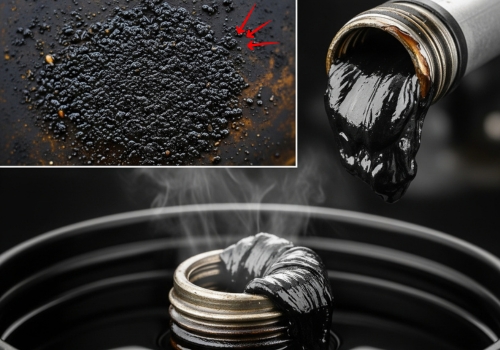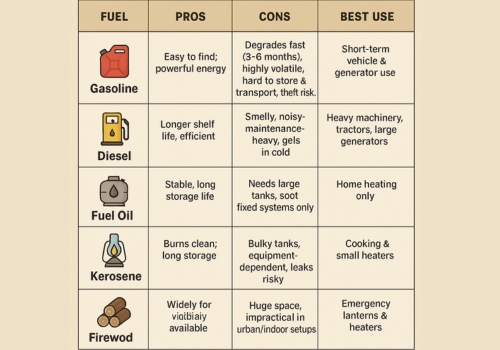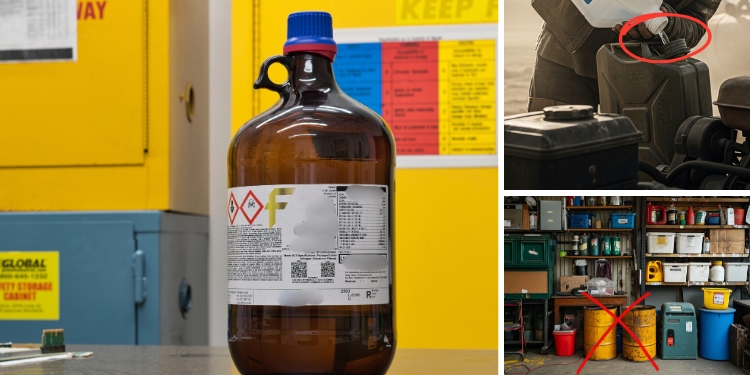When it comes to prepping, everyone’s got strong opinions on the best fuel source to stockpile for the long haul. Gasoline, diesel, propane, and even good old firewood all take the spotlight when it comes to short-term survival fuels.
Yet each has its own set of crippling drawbacks that can throw a wrench into your long-term survival plan. After years of testing, failing, and learning the hard way, I’ve narrowed down my choice to a surprising but rock-solid solution: isopropyl alcohol. It’s the one I trust the most for versatility, safety, and longevity. Here’s why.
The Problem with Traditional Fuels
Traditional fuels like gasoline, diesel, and propane all have limitations that only get worse as time drags on. While they might get you by in a short-term crisis, they can become an expensive liability in a long-term stockpile.
How Long Can Gasoline Be Stored?
Not as long as most people think. Without a fuel stabilizer, gasoline starts to break down in as little as three to six months. Over time, it separates, loses volatility, and becomes less effective—if not downright harmful—for engines. Even treated gasoline typically maxes out at about one to two years before performance degrades significantly.
Storing gasoline also comes with serious challenges. It must be kept in approved, fireproof containers and away from heat sources to prevent vapor buildup, which can be both toxic and explosive. Cold weather can make things worse, increasing pressure fluctuations and the risk of condensation inside containers. And in a grid-down situation, having visible gas cans on your property isn’t just a safety hazard—it’s a beacon for theft, desperation, and unwanted attention.
Diesel Is Better Suited for Other Things
When it comes to stockpiling fuels, diesel is often praised for its longer shelf life compared to gasoline, especially with a good stabilizer mix.
Yet diesel fuel isn’t without issues. It’s thick, smelly, and leaves behind soot and residue when burned. This alone makes it poorly suited for indoor or small-space use.
Diesel engines and generators tend to be loud, bulky, and require ongoing maintenance. All that noise can draw in curious eyes and ears you don’t want around. If you have a homestead or retreat location as your long-term survival destination, every drop of diesel fuel needs to be saved for tractors, machinery, or big generators.
In cold weather, diesel can gel and become unusable without additives. In deep cold, diesel can gel into a waxy sludge, clogging fuel lines and rendering engines useless unless treated with anti-gel additives.

Fuel Oil Is Stable but Only Practical for Home Heating
These days, fuel oil is only really used in home heating systems. It’s relatively stable and can be stored for years with the right treatment.
Yet it requires large, stationary tanks and specialized furnaces or burners that aren’t portable or easily repaired. Fuel oil also produces heavy soot and emissions when burned, making it unsuitable for indoor cooking or small-space heating.
If you already have a fuel oil furnace installed in your home, it’s fine to top up the tank and stockpile a secondary tank. Then use the furnace sparingly to get through the first winter. Otherwise, it really doesn’t have any other long-term stockpile value.
👉 How to Build the Oven That Cooks Without Fire, Fuel, Smell, or Smoke
Propane Is Bulky & Equipment-Dependent
As a stockpile fuel, propane burns clean and stores longer than gasoline, but the tanks are cumbersome. You’re also reliant on equipment like stoves or heaters that are compatible with propane regulators. If any part of that system fails, or a tank leaks, you’re left with a large metal container and no fire.
If you do choose to rely on propane, make sure you’re storing it in a large tank—like a 250 lb propane tank—rather than stacking up multiple small cylinders. Larger tanks are more efficient in long-term situations, reduce the risk of frequent handling, and are far less likely to run out when you need them most. They’re also easier to connect to backup home systems or high-output appliances. While installation is more expensive and may require a licensed professional, the long-term benefits in a grid-down or off-grid scenario far outweigh the hassle. Just keep in mind: once it’s empty, refilling may not be an option—so use it wisely.
Kerosene Is Useful But Dirty and Outdated
Kerosene has long been used for lighting and heating in lanterns and space heaters, but it’s far from ideal as a long-term stockpile fuel. While it stores better than gasoline, it still degrades over time and can attract moisture and even mold if not kept airtight. It burns with a strong odor and produces soot, which can cause indoor air quality issues and leave residue on walls and ceilings.
Kerosene appliances are bulky, outdated, and increasingly hard to find or replace parts for. Storing large amounts of kerosene safely is a fire risk and requires metal containers that are expensive and cumbersome.
Kerosene stoves, once a staple in off-grid and rural homes, come with their own set of drawbacks. While they’re capable of producing steady heat for cooking, they burn dirty, emitting strong fumes that can quickly overwhelm a small space. Prolonged use indoors—especially without proper ventilation—can lead to respiratory irritation or worse. And unlike propane or alcohol stoves, kerosene models require regular cleaning and wick maintenance just to function properly, which isn’t ideal in an emergency scenario.
Add to that the diminishing availability of kerosene itself in many parts of the country, and it becomes clear why relying on it as a primary backup fuel isn’t sustainable. Few retailers keep it in stock anymore, and even fewer carry stove-compatible grades. If you’re thinking long-term resilience, there are cleaner-burning, more efficient, and easier-to-store fuel options out there that don’t involve lugging around jugs of flammable liquid or tracking down spare parts from the 1980s.
Firewood Space Hog & Not Always Practical
While it’s the oldest fuel known to man, firewood takes up massive amounts of space and is only practical in specific environments. Wet climates, apartment settings, and other urban bug-in locations make it difficult to store and use firewood.

Is Isopropyl Alcohol the Same as Rubbing Alcohol?
Now moving on to my favourite fuel. Many folks wonder: is isopropyl alcohol the same as rubbing alcohol? The short answer is no, although they’re closely related. Isopropyl alcohol (IPA) is the pure chemical compound, usually sold in high concentrations like 70% or 99%. It’s a strong disinfectant and evaporates quickly.
On the other hand, rubbing alcohol is a diluted solution, generally around 70% isopropyl or sometimes ethyl alcohol mixed with water and other additives like denaturants or fragrances. These additives make it safer for skin use and help prevent misuse.
Good To Know: 70 vs 91 isopropyl alcohol
The main difference between 70% and 91% isopropyl alcohol lies in their water content, which affects how they clean and disinfect.
70% isopropyl alcohol contains 30% water, which actually makes it more effective for disinfecting surfaces. The water slows the evaporation rate, giving the alcohol more time to penetrate cell walls and kill bacteria, viruses, and fungi. This makes 70% ideal for general sanitizing, wound cleaning, and household use.
91% isopropyl alcohol, with only 9% water, evaporates much faster and is better suited for tasks where moisture is a problem—like cleaning electronics, removing adhesives, or prepping surfaces for paint. It can disinfect, but because it evaporates so quickly, it may not stay on surfaces long enough to kill all germs effectively.
In short, use 70% for disinfection and 91% for quick-dry cleaning or solvent tasks. The higher concentration might seem stronger, but in many disinfecting scenarios, the 70% solution is actually more effective.
If you’re even a little suspicious about the water coming from your tap these days, there’s a game-changing solution you should seriously consider.
It’s a backpack-sized water generator that literally extracts fresh, clean water straight from the air around you. This isn’t some futuristic fantasy; it’s the exact same technology the Israeli military relies on to keep their soldiers alive in scorching, off-grid environments. This compact powerhouse can produce up to 50 gallons of crystal-clear drinking water every single day.
Why Isopropyl Alcohol Is a Great Stockpile Fuel
Its versatility, stability, and ease of storage are just some of the reasons why I like isopropyl alcohol (IPA) as a long-term stockpile fuel.
Available in Different Concentrations
The most common types are 70% and 91% isopropyl alcohol. The 91% burns more efficiently, making it ideal for fuel use. The 70% variety is better for sanitizing skin but still works as a burner in a pinch. If you find 99% or anhydrous forms, consider that a prepper’s jackpot.
Versatility
Isopropyl alcohol isn’t just for first aid. It’s an excellent multi-purpose fuel that burns clean, hot, and nearly smokeless when used properly. You can cook with it, sterilize tools, clean surfaces, and start campfires. You can even power certain alcohol stoves or improvise homemade tuna can burners.
Just like these 4 essential antibiotics that people stockpile, isopropyl alcohol can be used for medical purposes, especially in emergency or survival situations. It is commonly applied to disinfect the skin before injections, clean small cuts or scrapes, and sanitize medical tools or surfaces.
However, it should never be used on deep wounds, large burns, or ingested internally, as it can irritate tissues and delay healing. For effective disinfection, a 70% concentration is recommended since higher concentrations evaporate too quickly.
Easy to Store and Transport
Unlike propane or gasoline, isopropyl alcohol doesn’t require special pressurized containers. A few gallons can be tucked away on shelves, under beds, or in your bug-out bag without taking up much room or raising eyebrows.
Does Isopropyl Alcohol Expire?
When kept sealed and stored in a cool, dark place, isopropyl alcohol can last indefinitely. While some manufacturers list an expiration date of 2–3 years, this is mainly due to FDA labeling regulations. In practice, the chemical structure remains stable for many years. Providing it’s not exposed to sunlight.
Safe for Indoor Use with Ventilation
Another great thing about isopropyl alcohol is that it burns without producing deadly carbon monoxide. While you should still ventilate to avoid vapor buildup, it’s much safer to burn in small, enclosed spaces than fossil fuels.
How To Store Isopropyl Alcohol Long-Term
Storage matters when it comes to stockpiling isopropyl alcohol as a long-term fuel source.
Use the Right Containers
Isopropyl alcohol tightly sealed plastic bottles, preferably HDPE (high-density polyethylene), which resist chemical degradation. You can also use glass containers like old mason jars or glass bottles with resealable lids.
Avoid Direct Sunlight
Store isopropyl alcohol containers in a dark cabinet, closet, or in tote bin under the bed. Sunlight can degrade isopropyl alcohol’s carbon chains. The heat of direct sunlight over time can also start to warp plastic storage containers or cause photodegradation-related leaks.
If you want to store isopropyl alcohol in big quantities for the long haul, or if you’re looking to keep other critical supplies safe and ready for when disaster strikes, one bold option is to bury a shipping container right in your backyard. This gives you a massive, hidden space to stash everything you might need when the world goes sideways.
However — and this is a big one — there’s a serious problem. Burying a shipping container is costly, back-breaking, and downright risky. Moisture can easily seep in and destroy your life-saving supplies when you need them most.
That’s why there’s a smarter, safer alternative. The Easy Cellar is basically an underground bunker that you can build quickly and easily, all by yourself, at a very small cost. You can even set it up right under your house. Besides giving you a secure storage space for fuel, food, and other vital gear, it can double as a survival bunker, ready to shield you from a nuclear blast, EMP attack, or any other nightmare scenario that might come our way.
When SHTF, you’ll be grateful you chose a rock-solid, stealthy, and fail-proof option to protect what matters most.
Cool Stable Storage Temperature
Higher temperatures can cause a slow evaporation effect in isopropyl alcohol. In the extreme, it can lead to pressure buildup inside a tightly sealed container. Ideally, you want to store your IPA containers in a basement or a climate-controlled garage.
Label with Concentration Percentage
Always label the concentration of the isopropyl alcohol in your fuel stockpile and include the date. Keep 70% and 91% separated. Different concentrations have different ideal uses. You don’t want to use 91% for disinfecting and then try to burn 70% in a tuna can stove.

Rotate Your Supply
Rotating your stockpile of isopropyl alcohol goes a long way toward ensuring you always have a high-quality supply. Especially if you can’t always keep it in ideal conditions. Use older stock for cleaning or first aid, and replace with fresh bottles.
Developing a Fuel Stockpiling Strategy
You don’t need to break the bank to enhance your fuel stockpile with isopropyl alcohol. Start with 10 bottles of 91% IPA from your local pharmacy, dollar store, or big-box retailer.
Include a small alcohol stove, like a Trangia, Solo Stove Alcohol Burner, or the basic tools to make one. Include fireproof pads or windshields for safer indoor use
Store bottles in multiple locations in your home, bug-out bag, basements, outbuildings and even in a ground-stash at the edge of your property. This ensures that you’re never without fuel. Even if you have to evacuate your primary shelter.
Gradually increase your supply with every shopping trip. Even one extra bottle a week adds up fast.
More on Isopropyl Alcohol Storage Safety
Isopropyl alcohol is very flammable and should never be stored near open flames or heat sources. Use only approved alcohol stoves or heat-resistant containers.
Avoid spilling large quantities of IPA as it evaporates quickly and can form combustible vapor clouds. Don’t inhale fumes in confined spaces. If you do spill, your top priority is to improve ventilation.
 Attention! Storing isopropyl alcohol in electronic-controlled containers or relying on electronic ventilation or fire suppression systems poses a serious risk. An EMP event could disable these systems, potentially causing dangerous vapor buildup or leaks.
Attention! Storing isopropyl alcohol in electronic-controlled containers or relying on electronic ventilation or fire suppression systems poses a serious risk. An EMP event could disable these systems, potentially causing dangerous vapor buildup or leaks.
Protect your valuable supplies and safety by shielding electronic equipment and containers with this EMP Cloth — a reliable barrier that safeguards against EMP effects. This solution provides 98% military-grade protection against electromagnetic waves and is great if you want to:
- Protect Your Vital Home Appliances (Laptop, Radio, Walkie-Talkie)
- Keep Your Credit Card Safe
- Effectively block 5G and Wi-Fi
Final Thoughts
When developing a fuel stockpile strategy, isopropyl alcohol isn’t flashy, but its versatility comes in handy. You can use it to heat, cook, clean, sterilize, and disinfect. It’s cheap, legal, shelf-stable, and wildly underappreciated in the prepping community.
Just be sure to store it in a cool, dark place away from any sunlight or heat sources. Rotating through older stocks of isopropyl alcohol also ensures that you’ll always have the highest quality IPA in your fuel stockpile.
Fuel is one of the most important elements you should stockpile. If you want to find the complete list of essentials and the smartest ways to store them, I recommend A Navy SEAL’s Bug-In Guide by survival expert Joel Lambert.
You may also like:
Amish Survival Hacks For a Long-Term Blackout (Video)
These Fuel Storage Mistakes Could Kill You
The Best Places Where You Can Store Fuels Safely In An Emergency























Cool dark places are like global whatever BS…they don’t exist where I live in the siuth!
Totally get that – storing anything long-term in hot, humid climates like the South is a challenge. A reason why isopropyl alcohol is better than many other fuels is that it doesn’t require refrigeration or perfect storage conditions to remain viable. But still, yeah, it’s not ideal to keep it in direct sun or heat, of course.
Dark is easy to find in the deserts of Arizona, cool … not so easy. While we still have the resources for Air Conditioning, sure, anywhere in your home is cool, if you have a thick enough wallet, but otherwise, deep enough underground is your only real resource, and you better find a pick axe, have a strong back, and lots of time on your hands or a back hoe to dig deep enough to find cool. With water lines to homes buried often a foot or two underground, during the summer, we don’t need a hot water heater … the sun bakes the ground and heats our water for us.
We heat predominantly with wood, maintaining a four year supply. We also have a 275 gallon tank of K1 for backup. The K1 becomes useless for heating without electricity but is great in oil lamps. We built a brick wood burning oven and stove outside and the mountain next to us will provide replenishment to our fuel supply. Old school dictates that additional wicks should be stored in the fuel basin of the oil lamps. Similar lamps can be used for spare parts when breakage occurs. K1 stoves are only better than nothing.
That sounds like a solid and well-thought-out setup – especially with a multi-year wood supply and a brick stove. Old-school methods are often the most resilient. I agree that kerosene has its place (especially for lighting), but having a secondary, portable, low-fume option like IPA is something I see as an extra layer. It’s not meant to replace wood or K1 – just to complement them in very specific use cases. Backup for your backup, so to speak.
For lighting, I have small solar panels at the house. Rechargeable batteries for the lamps. Burning anything is too hot here in the South- and stinky. I can charge all the small stuff on the 2 solar panels…can even use them on a car battery so no need for one of those “battery things they call a generator.”
I would think that can get expensive. 1 pint at the $1.25 store = $10 per gallon. And then, I would have to have alcohol burning equipment. Do they even make a generator that runs on alcohol? Or a car, truck or tractor?
I do have several bottles of 90% IPA. I also have several gallons of gas and kerosene as well as a little over 100 pounds of propane. I like to try to cover all my bases with fuels.
That’s a great point – IPA isn’t for powering generators or vehicles. It’s definitely not a “bulk fuel” solution like gas or propane. It’s more of a niche reserve: for small alcohol stoves, emergency fire-starting, or sterilization. The value is in its versatility and shelf stability, not in large-scale energy output. And yeah, $10/gal seems steep – but if bought in bulk, especially by the gallon at medical supply outlets, the price per unit drops a lot.
The one Item Left out is Sterno or canned fuels
usually small dose items for backpacking
can be a great fire starter when using with other fuel sources
shelf life is better because it is a canned item , sealed
if expense is not an issue and storage is
Space is precious so you have to look at
life of items , shelf life
Great addition – Sterno and canned fuels definitely have a place in any compact or mobile setup. I think of IPA and canned fuels like cousins: both are clean-burning, shelf-stable, and useful in different roles. IPA shines in versatility (medical + fuel), while Sterno wins on convenience. Good point about shelf life and space; both are critical when planning long-term.
Howdy from high in the desert swamp,
Depending on which scenario plays out, determines the stocking up. I have used sterno cans for close to 30 years. I have lit wet wood. Started a bonfire of cardboard and termite filled boards. Every time I pulled one out the people around me were surprised and oh man, I am getting a case of those. In nearly every situation either planned or okay, we camp here, the sterno was the saving grace. Im just one voice but I hope it’s loud. Sterno cans are on my list and in just about every pack or bag I have.
Remember the Alamo
Remember 9/11
Remember North Carolina
Remember to have your soul prepared
Non ethanol gasoline treated PRI-G and Diesel with PRI-D
are the only way to go in a SHTF world.
My treated fuels are still good at 3-4 years. Anything else is
just bullshit.
It seems like a lot of articles are just filling space.
Do some research.
Yes. I keep a supply of treated gasoline that gets used through the year fueling outdoor/wood processing equipment. Never had an issue. Besides a stabilizer I add a carb/injector cleaner and a fuel drier like “heet”. Always a reliable fuel. I also keep a few 20 lb propane tanks full for outdoor grill, stove and the gen set for our pump house. Be sure to store two cycle engine oil as well as bar oil if you use a chainsaw.
That’s a solid system – and I fully agree, PRI-G and PRI-D are gold when it comes to fuel preservation.
And articles like this aim to highlight those “third-string” options that might get overlooked, not replace the fundamentals where they are a must. Appreciate your perspective.
if your going to the trouble of storing isopropyl alcohol why not make it moon shine !
Haha, moonshine definitely has its uses – and it’s a renewable resource if you know what you’re doing! That said, the appeal of IPA is consistency, purity (especially 99%), and legality. It’s ready to go, and doesn’t require distillation, permits, or time.
Kerosene is not given enough credit, I think. The author’s own evaluation is at odds with the spreadsheet in the same article. Properly used, kerosene burns cleanly in Aladdin lamps, and wick heaters, such as Perfection and Aladdin.
Kerosene stoves were in widespread use from the early 20th century through the 1940s. They replaced the wood stoves and worked quite well. Natural gas and propane were still easier to use, and the replaced kerosene. I have a dual-burner kerosene burner for cooking, and it’s very clean and effective, though not as easy to use as propane.
Kerosene is SAFER to store and use than propane, gasoline, and alcohol. It is NOT explosive at all. It can also be mixed with diesel to make diesel immune to cold temperatures.
Our shtf plan is to use wood stove as primary heat ( in our 250 year-old New England house ), with kerosene space heaters as necessary. We’ve been using the kerosene heaters for 20 years already.
I really appreciate this well-informed breakdown – kerosene definitely has a proud legacy, and it remains one of the safest liquid fuels to store. I agree, its lower volatility makes it a great choice. I think the article was just spotlighting IPA as a niche addition to diversify fuel supplies. Redundancy is key – and it’s great to see a plan like yours that’s already tested over decades.
By my research, a decent craft brewed IPA is around 20.00/gal. A gallon of 90% IPA suitable for heating is 40.00/gal. So, it’s craft IPA for my long term needs, even though it is best stored at 35F.
Back in the 60s Andy Granatelli engineered an alcohol fueled steam turbine race car and entered it in the Indy 500. Both years he ran those cars they looked unbeatable, only to drop out from minor mechanical problems like a broken throttle linkage. They were so much faster, so much more efficient than the other ICE powered cars that they were banned. And that was the end of that technology. Alcohol fuel never developed as an industry and remains too expensive to use, both the fuel and the stoves and heaters to burn it.
Sterno used to be a go to fuel for camping and hard times, it was so cheap skid row winos would kill themselves trying to drink the alcohol from it. But even Sterno is high nowadays.
I have relatives in southern Missouri, surprise, making Moonshine is a popular hobby there. I’d bet I’m the only person reading AskAPrepper who knows that the Raccoon baculum, inserted into the end of the condensing tube, is the traditional method for metering flow from the still. I bet I’m the only person here who actually has a bag of Raccoon baculae, inherited from a coon hunting great uncle. Anyway, bet a lot of moonshiners out there end up powering the post SHTF economy.
That was quite the journey – from IPA to raccoon baculae! 😄 Love the historical reference to Granatelli’s turbine cars, too. You’re absolutely right that alcohol fuel never really took off for vehicles, and cost is a factor. The use case in the article is more for emergency heat, cooking and sanitation than engines. That said, your comment was fascinating – and yes, moonshine might just run the post-SHTF economy!
This piece of advice is really, really risky, Claude. In any kind of confined space, IPA can pose an explosion hazard. All it takes is a spark, like switching on a light to cause an explosion. And the space doesn’t have to be sealed. The vapor accumulates in undisturbed air where it mixes with available oxygen to go boom. No joke. I accidentally caused a vapor expllosion that caused flash burns on my hands and face. Shredded the skin; it was just hanging from me. I was sooooo lucky the damage wasn’t worse. I think pellet stoves, solar ovens, photovoltaic panels, and fat are my preferred emergency supplies. The fat, like lard or tallow, can be used as fire starters, converted into soap (with wood-ash filtrate), or made into candles, especially with beeswax added. (Beeswax is a commodity and recent prices range from $12.50 to about $30/lb.). Keep the IPA as a disinfectant and MAYBE for itty-bitty sloves, like the double loop backpacking stove.
Thank you for sharing your experience, Jay! That sounds terrifying, and I’m really glad you made it through. You’re absolutely right: IPA vapors are flammable and can ignite in the right air-to-vapor mix.
This is why any use indoors must be with extreme caution, proper ventilation, and small quantities. IPA isn’t meant for enclosed-space heating, but for small, controlled uses like in alcohol stoves or sterilization.
Your warning is important, and it’s a reminder that any fuel requires respect and safety protocols.
Oops! That should be “…$2.50 to about $30/lb.” Wide price variation.
Having lived on a boat that had an alcohol stove, I will say that the first thing I did was get rid of the darn thing. It takes forever to heat anything because it has a lower burning temperature. Also, everyone with an alcohol stove knows what it is like to have eyebrows burned off or hair catch fire. You can’t see the flame. Takes more fuel, too.
If it is truly an SHTF situation long term, I believe the best thing is a rocket type stove. They don’t take much fuel and you can use most anything from paper to leaves, sticks…..
Nobody can store sufficient fuel for long term.
We lived 6-9 months off the grid each year for 22 years. One time it was 4 months without a shower (I’m female). Washing up works. We had 3 gallons of water/day total 2 people & a dog. Toilets did not use fresh water. I can wash/rinse my hair in 2 large coffee mugs and then use the grey water elsewhere. It’s not going to be like anything most can imagine. We lived off solar, wind bugger, and propane. A rocket stove would do if we ran out of propane. I like my eyebrows.
I agree about alcohol stoves taking a long time to heat up anything. On the plus side, if you inadvertently catch something on fire with it, you can douse the flames with water.
For lighting, I have small solar panels at the house. Rechargeable batteries for the lamps. Burning anything is too hot here in the South- and stinky. I can charge all the small stuff on the 2 solar panels…can even use them on a car battery so no need for one of those “battery things they call a generator.”
Look up Origo stove if you’re interested in a cook stove. They sell on ebay all the time. I have one in a sailboat and it is simple to operate and use – think of a sterno can with an adjustable wick, although the heat output is lower than propane or other liquid fuel stoves. They are designed for use with denatured alcohol – which is basically IPA but not as pure and is also available at most hardware stores in gallons in paint section. I’d take a good look at denatured alcohol over IPA if you’re using it primarily for cooking over first aid.
Thanks for sharing that, great point! The Origo stove is a solid option, especially for folks who want something safe and simple, like on a sailboat or in an off-grid cabin. You’re absolutely right — denatured alcohol is often a more practical choice for cooking since it’s easier to find in bulk at hardware stores and usually cheaper than high-purity IPA.
Can not believe the line about burying a shipping container in the backyard after all the times I have seen the artical about how they collapse from ground pressure.
I worked in a plastic moulding shop years ago where we got IPA in five gallon plastic jugs. Used it for cleaning injection molds. Still have a couple of the emptys around for water jugs.
Here in the northern Allegheny mountains in rural areas cool storage is easy. A semi buried room in a hillside with a flowing spring stays cool in the hottest weather and does not freeze in subzero winter, humid though.
Making your own alcohol is doable especialy if you can grow some sorghum for feed stock
Hi, Dave! Indeed, burying a shipping container is a bad option. The article clearly mentions that it’s a storage solution many folks turn to because it offers a lot of space, but it is a bold option and it has “a serious problem. Burying a shipping container is costly, back-breaking, and downright risky.” So, even in the article, this option was labeled as one better left alone, and the alternative presented (The Easy Cellar) is a much better choice.
Great input, still! Areas like the one you live in are much more friendly to folks who want to stockpile IPA.